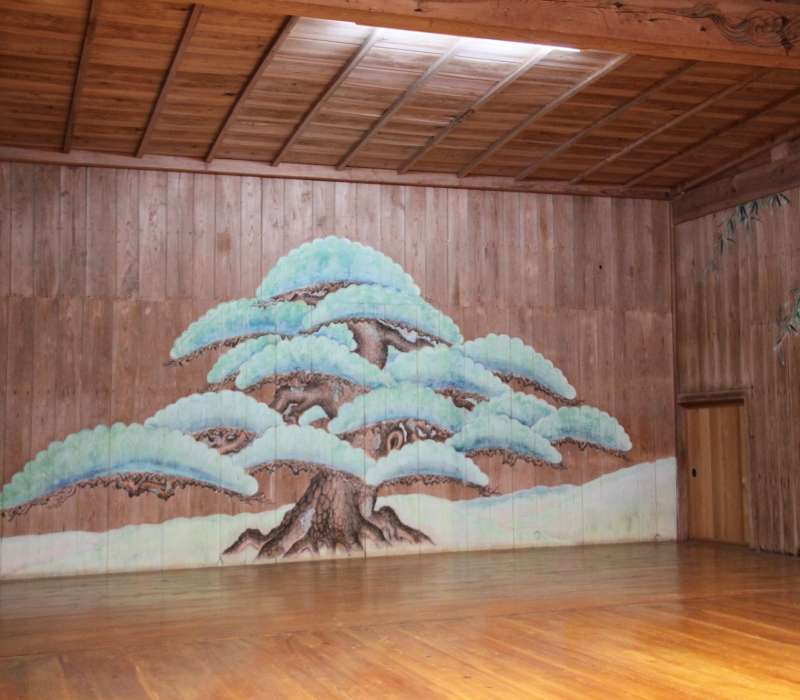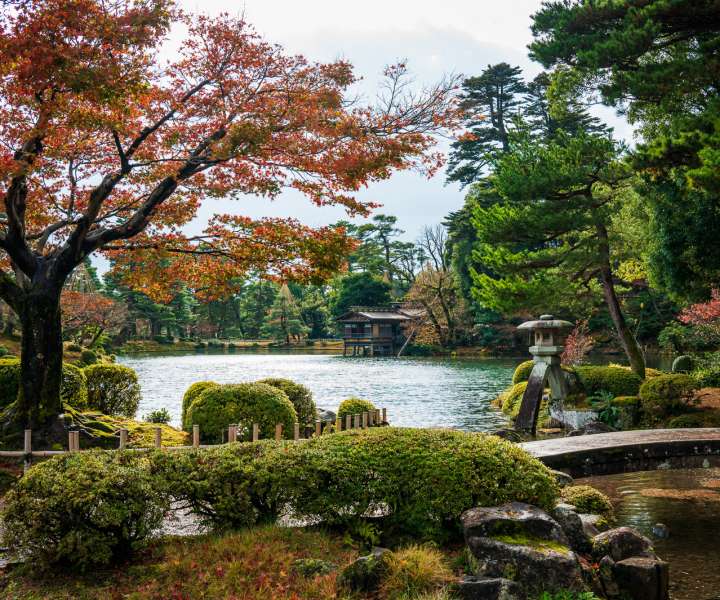
Traditional arts and performance arts are integral parts of Japanese culture. Experiencing them will help us gain a better understanding of Japanese aesthetic sensibilities, and how they convey beauty and spirituality. Precision and attention to detail, along with a keen interest in nature, both from a religious and aesthetical point of view, become entangled in several unique cultural manifestations. These forms of expression range from musical and theatrical performances, to architecture and landscape design. And more often than not, there’s a ritualistic component to them. On your next trip to Japan, do not miss the extraordinary world of Japanese traditional arts, for an unforgettable experience.
Timeless Noh Culture on Sado Island

Noh is a traditional form of Japanese theatre that originated between the 12th and 13th centuries. Typically, Noh plays are based on Japanese folk tales and often represent stories about love, loss, and the supernatural. Some of its defining traits are the use of masks, elaborate costumes, and highly stylized movements and gestures. And while this is a cultural art form found throughout Japan, Sado Island, located off the coast of Niigata Prefecture, has a long and very special relationship with Noh culture.
Noh tends to be perceived as an elitist art form, developed to entertain the nobility, but its evolution in Sado was linked to local shrines and its popularity spread as entertainment for the common people. As a result, Noh became an essential part of the islanders’ culture and as such, has been passed down through the generations. Nowadays, Noh is thriving on the island thanks to numerous Noh theatres, and just as many Noh schools where new generations continue to learn and develop this art. The tradition is further kept alive through several Noh festivals and events held on the island throughout the year, attracting visitors from all over Japan and beyond.
A key component in maintaining this culture lies in the practitioners’ openness to adapt Noh to modern times. Traditional Noh plays may also blend with a variety of theatre, music, and dance performances, allowing Noh to breathe and evolve with the times and its people. A great example is the Earth Celebration, a vibrant and exciting annual arts and culture festival hosted by Kodo, a world-renowned taiko ensemble based in Sado Island. Since 1988, the Earth Celebration showcases a cultural explosion throughout three days of musical and cultural performances on many of the island’s Noh stages, which celebrate nature, earth, the local culture of Sado, and its cultural links around the world. With 35 years of history, this festival is one of the greatest cultural and musical events in Japan.
Mountain Worship at Dewa Sanza
Japan’s sacred mountains of Dewa Sanzan, or “three mountains of Dewa” in Yamagata Prefecture, are a mystical and serene destination where ancient spiritual practices become intertwined with a profound connection and reverence to nature. These three peaks, Hagurosan, Gassan, and Yudonosan -each symbolizing birth, death, and rebirth, respectively-, have been revered for over a thousand years by the Yamabushi, ascetic mountain hermits who undertake spiritual quests to deepen their enlightenment.
Visitors seeking an immersive experience at Dewa Sanzan will find that staying at a Shukubo temple lodging will provide an experience like no other. These Buddhist temple lodgings are not just a place to rest for those on a pilgrimage, but a portal to another world; one of early morning prayers, ascetic training and nourishing vegetarian meals in consonance with Buddhist teachings and practices. A peaceful atmosphere, surrounded by the beauty of nature, makes a Shokubo experience the perfect environment to seek spiritual growth.
The Yamabushi practices, however, incorporate more than just Buddhism. Their religion, Shugendo, is a millenarian form of mountain worship that integrates Buddhism with Shinto and Taoism. They believe in the power of nature and the role it plays in the pursuit of spiritual elevation. Their practices involve performing rituals in the forests and rivers surrounding the mountains as part of a spiritual journey. This way, the Dewa Sanzan pilgrimage serves both the purpose of self-renovation or rebirth, while in commune with spirits of nature. One of the most unique aspects of the Yamabushi is the fire rituals, as fire is believed to purify the body, mind and soul. A fascinating spectacle to witness, with the ascetic monks spinning fire in their hands and chanting mantras as they mediate. Shugendo practices are demanding. Often involve undertaking long periods of fasting, meditating in the cold or even under freezing waterfalls or sleeping on bedrolls made of branches. Seemingly extreme actions from an outside perspective, but a rewarding sacrifice to be made in exchange for enlightenment.
Regardless of age or origin, seeking to attain the status of Yamabushi is open to anyone. The journey begins with the week-long Akinomine Autumn Peak Ritual. An ancient rite of passage shrouded in secrecy but said to involve more than just physical endurance and meditation. It’s a test of one’s spirit, as the initiate must navigate the dark and holy paths of the mountains and seek its divine guidance. Those who complete the ritual are able to become certified as Yamabushi, and many repeat the same ritual every year, as a way to forge their lifelong spiritual journey.
Geiko and Maiko, a Fixture of Some of The Most Prominent Traditional Neighbourhoods in Japan
Geisha are traditional Japanese entertainers who spend years training and mastering a wide range of arts of music, dance, and conversation. In Kyoto, they are known as Geiko, while in Ishikawa and Niigata, they’re called Geigi. Maiko, on the other hand, are the young apprentices, between the ages of 15 and 20, that are still in training. These performers are typically associated with the old neighbourhoods of Gion and Nichinenzaka in Kyoto, Higashi Chaya in Kanazawa, and Furumachi in Niigata, which are known for their historic streets and traditional wooden buildings.
While strolling around these neighbourhoods, it’s common to see geiko/geigi or maiko coming and going between tea houses or to and from private performances. We can distinguish the young maiko from their more professional peers by their longer and more colourful kimono, which are adorned with intricate patterns and designs, as well as their eye-catching hair ornaments. Their striking appearance is meant to compensate for their lack of experience, which is why, in contrast, professionally established geiko wear subtler outfits and more subdued ornaments as a display of maturity and reliance on pure skill rather than looks.
When thinking of traditional Japanese townscapes, one of the most commonly conjured evocations is the sights of these beautiful, and gracefully ornate geiko, geigi or maiko, quietly walking around the narrow, winding alleys and old wooden buildings of these historic neighbourhoods, where the timeless quality of old and new shops and restaurants inspire a sense of history and cultural tradition.
Gion and Ninenzaka
Gion, in particular, is famous for its narrow, cobbled streets and traditional houses, which were once home to merchants and artisans. Today, many of these houses have been converted into restaurants, tea houses, and other businesses that cater to tourists and locals alike. The area is also known for its many shrines and temples, which are surrounded by trees and gardens and offer a peaceful retreat from the bustle of the city. Ninenzaka, on the other hand, is known for its steep, winding streets that lead up to Kiyomizu Temple. This temple, which is one of the most famous in Kyoto, is built on a hill and offers stunning views of the city and surrounding mountains.
Higashi Chaya

Higashi Chaya, in Kanazawa, is another historic neighbourhood where its narrow streets lined with traditional wooden machiya houses come alive with charming teahouses and old historical establishments. It’s in these places where maiko and geigi can be seen performing traditional arts for visitors. We can also find a variety of artisan shops and traditional restaurants in the vicinity that reflect Kanazawa’s rich cultural history.
Furumachi

Niigata’s Furumachi Geigi is the name that Niigata’s geisha are traditionally known for. The Furumachi district used to be one of Japan’s most prominent entertainment districts during the Edo period. And although nowadays it’s mostly a business and commercial district, the old town ambiance remains on its streets. Apart from normal performances in traditional establishments, the gorgeous Niigata Saito Villa holds geigi performances with the memorable surroundings of a beautiful Japanese style garden.
Gardens, the Soul of Japanese Traditional Aesthetics
Few places have elevated the enjoyment of one’s own surroundings to such sophisticated lengths as Japan has done with the refinement of their garden design. Either for recreational or spiritual purposes, the variety of design elements meant to represent nature or to convey different feelings make each visit to a Japanese garden its own unique experience and an excellent opportunity to learn about the history and traditional aesthetics behind each place. The following are some of the best examples of artistic beauty in Japanese landscape design:
Korakuen Garden

Korakuen Garden, in Okayama, is a prime example of a Japanese garden. It was built in the late 17th century by a feudal lord as a place for leisure and entertainment of his guests, right outside Okayama Castle. The garden features a large pond with several streams and walking paths, as well as a hill serving as a vantage point to enjoy the general landscape. One of the most notable features of Korakuen Gardens is its use of "borrowed scenery," which involves incorporating views of the surrounding landscape into the garden design. In this case, the imposing magnificence of the neighbouring fortress of Okayama Castle sits in contrast to the garden as a beautifully designed structure that also had defensive purposes.
Kokoen Garden

Kokoen Gardens, located in Himeji, are a notable example of the combination of a Japanese garden next to a castle; in this case, Himeji Castle. However, despite its appearance as a historical garden, it’s a series of nine separate gardens built just 31 years ago following historical garden design characteristics from the Edo Period. It masterfully combines all the elements we may expect from a historical garden, such as a pond with a waterfall, flower gardens, bamboo gardens and a teahouse, among other things. From these gardens, we can also enjoy privileged views of Himeji Castle, regarded as one of the finest examples of Japanese castle architecture and designated as a UNESCO World Heritage site.
Japanese Gardens of the Adachi Museum of Art
The Japanese gardens of the Adachi Museum of Art in Yasugi, Shimane Prefecture, are the absolute best highlights of the museum. Since its founding in 1970, the museum’s garden design has been consistently ranked internationally among the top Japanese gardens. Surrounding the museum building, it covers a variety of different styles, such as a moss garden, a dry garden, and a white gravel and pine garden. Unfortunately, the garden cannot be entered, but its sights can be enjoyed with the changing seasons from the museum building.




















































